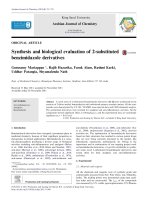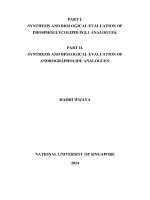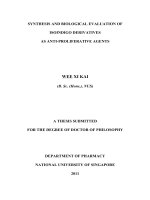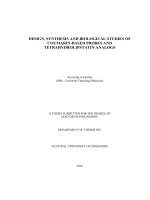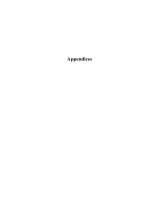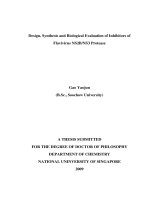Synthesis and biological evaluation of 2 substituted benzimidazole derivatives
Bạn đang xem bản rút gọn của tài liệu. Xem và tải ngay bản đầy đủ của tài liệu tại đây (314.89 KB, 5 trang )
ORIGINAL ARTICLE
Synthesis and biological evaluation of 2-substituted
benzimidazole derivatives
Gurusamy Mariappan
*
, Rajib Hazarika, Faruk Alam, Rashmi Karki,
Uddhav Patangia, Shyamalendu Nath
Dept. of Medicinal Chemistry, Himalayan Pharmacy Institute, Majhitar, East-Sikkim 737 136, India
Received 31 May 2011; accepted 22 November 2011
Available online 28 November 2011
KEYWORDS
Anti-inflammatory;
Analgesic;
Benzimidazole
Abstract A novel series of 2-substituted benzimidazole derivatives (3a–3j) were synthesized by the
reaction of 2-chloro methyl benzimidazole with substituted primary aromatic amines. All the com-
pounds were characterized by UV, IR,
1
H NMR, mass spectral data and CHN elemental analysis.
The synthesized derivatives were screened for analgesic and anti-inflammatory activities. All the
compounds showed significant effect at 100 mg/kg p.o. and the experimental data are statistically
significant at p < 0.01 level.
ª 2011 Production and hosting by Elsevier B.V. on behalf of King Saud University.
1. Introduction
Benzimidazole derivatives have occupied a prominent place in
medicinal chemistry because of their significant properties as
therapeutics in clinical applications. Benzimidazole is a versa-
tile pharmacophore producing a diverse range of biological
activities including anti-inflammatory and analgesic (Bahaa
et al., 2006; Kavitha et al., 2010; Khan and Nandan, 1997),
anti-ulcer (Bariwal et al., 2008), anti-fungal (Canan, 2003),
anti-microbial (Chhonker et al., 2009; Pathak et al., 2010;
Reddy et al., 2009), anthelmintic (Theodorides et al., 1976),
anti-cancer (Demirayak et al., 2002), anti-asthmatic and
anti-diabetic (Vinodkumar et al., 2008), anti-tubercular (Yar
et al., 2009), antiprotozoal (Zygmunt et al., 2002), antiviral
activities etc. The optimization of benzimidazole derivatives
based on their structures has resulted in various potent drugs
that are now being currently practiced in the market, like
albendazole, omeprazole, mebendazole, etc. Owing to the
importance and in continuation of our ongoing project work
on benzimidazole derivatives, it was felt worthwhile to synthe-
size some novel 2-substituted benzimidazole derivatives and
screen them for their analgesic and anti-inflammatory
activities.
2. Experimental
2.1. Materials and reagents
All the chemicals and reagents were of synthetic grade and
commercially procured from S.D. Fine Chem. Ltd. (Mumbai,
India). The melting points were determined using open capil-
lary tubes and are uncorrected. The k
max
of the compounds
was measured by UV–visible spectrophotometer (UV-Pharma
*
Corresponding author. Tel.: +91 9474530205; fax: +91 3592
246462.
E-mail address: (G. Mariappan).
Peer review under responsibility of King Saud University.
Production and hosting by Elsevier
Arabian Journal of Chemistry (2015) 8, 715–719
King Saud University
Arabian Journal of Chemistry
www.ksu.edu.sa
www.sciencedirect.com
1878-5352 ª 2011 Production and hosting by Elsevier B.V. on behalf of King Saud University.
/>Spec 1700, Shimadzu, Kyoto, Japan), IR spectra were re-
corded on FT-IR8400S, Fourier Transform (Shimadzu) Infra-
red spectrophotometer using KBr disk method.
1
H NMR
spectra were recorded on JEOL (JNM-ECS400, 400 MHz) in
dimethyl sulfoxide (DMSO-d
6
) using Tetramethylsilane as an
internal standard. The mass spectra were recorded on a Micro-
mass Q-TOF and Shimadzu LC–MS 2010A Mass spectrome-
ter and CHN elemental analysis was performed at Perkin
Elmer Autosystem XL analysis.
2.2. General procedure for the preparation of (1H-benzimidazol-
2-ylmethyl)-phenyl-amine derivatives
2.2.1. Step-1
A mixture of o-phenylenediamine (0.1 mol) and monochloro-
acetic acid (0.1 mol) was refluxed for 3 h in 4 N hydrochloric
acid (50 mL) on a water bath. The reaction mixture was cooled
and basified with ammonium hydroxide solution. The precipi-
tate thus obtained was dried and recrystallized from methanol
with activated charcoal treatment. The pure product obtained
was a slightly yellow colored crystal whose melting point was
150–152 °C and the yield was 89%.
2.2.2. Step-2
A mixture of 2-chloromethyl benzimidazole (0.01 mol),
substituted primary aromatic amine (0.01 mol) and KI
(0.01 mol) in 50 mL of ethanol was heated under reflux for
6 h, KOH (0.01 mol in 5 mL of water) was added with con-
tinuous stirring for 2 h. Finally the reaction mixture was left
aside at room temperature and then poured into crushed ice.
The solid product that precipitated was filtered off, recrystal-
lized from ethanol and dried in vacuum desiccators. The
synthetic route for the target compounds 3a–3j is shown in
Scheme 1.
2.2.2.1. (1H-Benzimidazol-2-ylmethyl)-(3,4-dichloro-phenyl)-
amine (3a). Yellow crystal; m.p. 187–192 °C; Yield 81%;
UV(ethanol) k
max
: 362; IR (KBr): m
max
in cm
À1
: N–H, 3433;
C–H(CH
2
), 3066; C‚C(Ar), 1600; C‚ N, 1492; C–H, 2891;
C–Cl, 744; Ar. Ring Vib., (995, 877, 829, 810),
1
H NMR
(DMSO-d
6
, 400 MHz) d: 2.52(s, 2H, CH
2
), 4.51(s, 1H, NH
aromatic), 6.66(s, 1H, NH benzimidazole), 6.88–7.52 (m,
7H, Ar-H); MS: 291 [M
+
]; Anal. calcd for C
14
H
11
Cl
2
N
3
(292): C 57.55, H 3.79, N 14.38; found C 57.29, H 3.65, N
14.45.
NH
2
NH
2
ClCH
2
COOH
NH
2
R
3
R
2
R
1
R
4
N
N
H
R
3
R
1
R
4
HN
R
2
N
N
H
CH
2
Cl
4N HCl,
2
KI, CH
3
CH
2
OH
KOH
80
O
C
1
3a-3j
Where,
Comp. code R
1
R
2
R
3
R
4
Comp. Code R
1
R
2
R
3
R
4
3a H Cl Cl H 3f H H F H
3b Cl Cl H H 3g Br H Br Br
3c NO
2
H H H 3h Cl H NO
2
H
3d H H NO
2
H 3i H H SO
2
NH
2
H
3e H NO
2
H H 3j H H I H
Scheme 1 The synthetic route of the target compounds.
716 G. Mariappan et al.
2.2.2.2. (1H-Benoimidazol-2-ylmethyl)-(2,3-dichloro-phenyl)-
amine (3b). Light yellow powder; m.p. 93–96 °C; Yield 56%;
UV(ethanol) k
max
: 281; IR (KBr): m
max
in cm
À1
: N-H, 3475;
C–H(CH
2
), 3080; C–H(Ar), 2821; C‚ N, 1585; C–Cl, 765;
Ar. Ring Vib., (902, 862, 700, 578);
1
H NMR (DMSO-d
6
,
400 MHz) d: 2.45(s, 2H, CH
2
), 4.59(s, 1H, NH aromatic),
6.56 (s, 1H, NH benzimidazole), 6.57–7.46(m, 7H, Ar-H);
MS: 292 (M
+
+1); Anal. calcd for C
14
H
11
Cl
2
N
3
(292): C
57.55, H 3.79, N 14.38; found C 57.34, H 3.73, N 14.33.
2.2.2.3. (1H-Benzimidazol-2-ylmethyl)-(2-nitro-phenyl)-amine
(3c). Orange crystal; m.p. 90–95 °C; yield 55%; UV(ethanol)
k
max
: 251; IR (KBr): m
max
in cm
À1
: N–H, 3637; C–H(CH
2
),
3466; C–H(Ar), 2899; C‚N, 1506; C–NO
2
, 746; Ar. Ring
Vib., (871, 848, 813, 783),
1
H NMR (DMSO-d
6
, 400 MHz) d:
2.49(s, 2H, CH
2
), 3.47(s, 1H, NH aromatic), 6.61(s, 1H, NH
benzimidazole), 6.69–7.93(m, 8H, Ar-H); MS: 268 [M
+
]; Anal.
calcd for C
14
H
12
N
4
O
2
(268): C 62.68, H 4.51, N 20.88; found C
62.56, H 4.58, N 20.73.
2.2.2.4. (1H-Benzimidazol-2-ylmethyl)-(4-nitro-phenyl)-amine
(3d). Brick red crystal; m.p. 140–150 °C; Yield 68%; UV(eth-
anol) k
max
: 382; IR (KBr): m
max
in cm
À1
: N–H, 3481; C–
H(CH
2
), 3363; C–H(Ar), 2914; C‚N, 1508; C–NO
2
, 756;
Ar. Ring Vib., (840, 632, 534, 489),
1
H NMR (DMSO-d
6
,
400 MHz) d: 2.50(s, 2H, CH
2
), 3.41(s, 1H, NH aromatic),
6.60(s, 1H, NH benzimidazole), 6.73–7.99(m, 8H, Ar-H);
MS: 268 [M
+
]; Anal. calcd for C
14
H
12
N
4
O
2
(268): C 62.68,
H 4.51, N 20.88; found C 62.74, H 4.49, N 20.78.
2.2.2.5. (1H-Benzimidazol-2-ylmethyl)-(3-nitro-phenyl)-amine
(3e). Yellow crystal; m.p. 177–179 °C; Yield 70%; UV(etha-
nol) k
max
: 252; IR (KBr): m
max
in cm
À1
: N–H, 3537; C–
H(CH
2
), 3444; C–H(Ar), 3363; C‚N, 1585; C–NO
2
, 738,
Ar. Ring Vib., (842, 790, 738, 669);
1
H NMR (DMSO-d
6
,
400 MHz) d: 2.50(s, 2H, CH
2
), 3.43(s, 1H, NH aromatic),
7.14(s, H, NH benzimidazole), 7.33–7.45(m, 8H, Ar-H); MS:
268 [M
+
]; Anal. calcd for C
14
H
12
N
4
O
2
(268): C 62.68, H
4.51, N 20.88; found C 62.66, H 4.53, N 20.83.
2.2.2.6. (1H-Benzimidazol-2-ylmethyl)-(4-fluoro-phenyl)-
amine (3f). Light gray crystal; m.p. 161–163 °C; Yield 76%;
UV(ethanol) k
max
: 281; IR (KBr): m
max
in cm
À1
: N–H, 3456;
C–H(CH
2
), 3358, C–H(Ar), 3059; C‚ N, 1589; C–F, 819;
Ar. Ring Vib., (752, 639, 605, 518, 482);
1
H NMR (DMSO-
d
6
, 400 MHz) d: 2.55(s, 2H, CH
2
), 3.44(s, 1H, NH aromatic),
6.29(s, 1H, NH benzimidazole), 6.30–7.18(m, 8H, Ar-H);
MS: 241 [M
+
]; Anal. calcd for C
14
H
12
FN
3
(241): C 69.70, H
5.01, N 17.42; found C 69.76, H 5.08, N 17.64.
2.2.2.7. (1H-Benzimidazol-2-ylmethyl)-(2,4,6-tribromo-phe-
nyl)-amine (3g). White crystal; m.p. 120–123 °C; Yield 68%;
UV(ethanol) k
max
: 251; IR (KBr): m
max
in cm
À1
: N–H, 3506;
C–H(CH
2
), 3452, C–H(Ar), 3288; C‚ N, 1564; C–Br, 860;
Ar. Ring Vib., (844, 732, 707, 673);
1
H NMR (DMSO-d
6
,
400 MHz) d: 2.08(s, 2H, CH
2
), 3.38(s, 1H, NH aromatic),
5.44(s, 1H, NH benzimidazole), 7.14–7.80(m, 6H, Ar-H);
MS: 460 [M
+
]; Anal. calcd for C
14
H
10
Br
3
N
3
(460): C 36.56,
H 2.19, N 9.14; found C 36.44, H 2.22, N 9.34.
2.2.2.8. (1H-Benzimidazol-2-ylmethyl)-(2-chloro-4-nitro-phe-
nyl)-amine (3h). Dark brown crystal; m.p. 160–161 °C; Yield
65%; UV(ethanol) k
max
: 364; IR (KBr): m
max
in cm
À1
: N–H,
3051; C–H(CH
2
), 2899, C–H(Ar), 2762; C‚N, 1442; C–
NO
2
, 740; C–Cl, 895, Ar. Ring Vib., (927, 842, 638);
1
H
NMR (DMSO-d
6
, 400 MHz) d: 2.05(s, 2H, CH
2
), 3.40(s, 1H,
NH aromatic), 6.77(s, 1H, NH benzimidazole), 6.79–8.07(m,
7H, Ar-H); MS: 302 [M
+
]; Anal. calcd for C
14
H
11
ClN
4
O
2
(303): C 55.55, H 3.66, N 18.51; found C 55.45, H 3.54, N
18.59.
2.2.2.9. 4-[(1H-Benzimidazol-2-ylmethyl)-amino]-benzene sul-
fonamide (3i). Pale yellow crystal; m.p. 254–256 °C; Yield
66%; UV(ethanol) k
max
: 267; IR (KBr): m
max
in cm
À1
: N–H,
3491; C–H(CH
2
), 3425; C–H(Ar), 3271; C‚ N, 1597; C–SO
2
,
1456; Ar. Ring Vib., (1001, 935, 898, 823, 748);
1
H NMR
(DMSO-d
6
, 400 MHz) d: 2.50(s, 2H, CH
2
), 4.54(s, 1H, NH
aromatic), 6.70(s, 1H, NH benzimidazole), 6.7–7.52(m, 8H,
Ar-H), 4.55(s, 2H, SO
2
NH
2
); MS: 302 [M
+
]; Anal. calcd for
C
14
H
14
N
4
O
2
S (302): C 55.61, H 4.67, N 18.53; found C
55.44, H 4.31, N 18.70.
2.2.2.10. (1H-Benzimidazol-2-ylmethyl)-(4-iodo-phenyl)-amine
(3j). Colorless powder; m.p.221–223 °C; Yield 72%; UV(eth-
anol) k
max
: 253; IR (KBr): m
max
in cm
À1
: C–I, 806; N–H,
3527; C–H(CH
2
), 3475; C–H(Ar), 3443; C‚N, 1589; Ar. Ring
Vib., (746, 690, 669, 576, 501);
1
H NMR (DMSO-d
6
,
400 MHz) d: 2.07(s, 2H, CH
2
), 4.44(s, 1H, NH aromatic),
6.46(s, 1H, NH benzimidazole), 7.11–7.33(m, 8H, Ar-H);
MS: 349 [M
+
]; Anal. calcd for C
14
H
12
IN
3
(349): C 48.16, H
3.46, N 12.03, found C 48.97, H 3.37, N 12.29.
2.3. Experimental animals
Adult Swiss albino mice (20–25 g) and albino rats weighing
(150–200 g) of either sex were used as experimental animals.
All the animals were housed in groups of 4–8 per cage at a tem-
perature of 25 ± 1 °C and a relative humidity of 45–55%. A
12 h dark and 12 h light cycle was followed during the experi-
ments. Animals were allowed free access to food and water
ad libitum . During the study period, guidelines of Committee
for the Purpose of Control and Supervision of Experiments
on Animals (CPCSEA), Institutional Animals Ethics Commit-
tee (IAEC) were followed for the maintenance of animals.
2.3.1. Acute toxicity studies
The acute toxicity studies were carried out in groups of six
Swiss albino mice, weighing 20–25 g which were fasted over-
night and treated orally with the test compounds. The dosage
was varied from 100–1000 mg/kg body weight orally. All the
animal experiments were performed with the approval of Insti-
tutional Animal Ethics Committee, Himalayan Pharmacy
Institute, East-Sikkim, India.
2.3.2. Analgesic activity by Tail-flick method in mice
The analgesic activity was carried out by Tail-flick (D’Armour
and Smith, 1941) method using Swiss albino mice. In this
method, heat is used as a source of pain. Overnight fasted
healthy and adult male Swiss albino mice weighing between
20 g and 25 g, in a group of six each were taken for the inves-
tigation. The animals were kept into a small cage with an open-
ing for the tail at the rear wall. The tail was held gently and a
light beam exerting radiant heat was directed to the proximal
third of the tail. The tip of the tail of the mice was individually
Synthesis and biological evaluation of 2-substituted benzimidazole derivatives 717
placed on the radiant heat source at constant temperature
55 °C. The cut-off reaction time was fixed at 15 s to avoid tis-
sue damage. The tail flick response was measured at 0 h, 1 h,
2 h, 3 h and 4 h after treatment of test compounds by digital
analgesiometer (INCO, Ambala, India). The drug pentazocine
(3.9 mg/kg, i.p.) was used as standard drug for comparison
and test groups received synthesized benzimidazole derivatives
at 100 mg/kg p.o.
2.3.3. Anti-inflammatory activity by Carrageenan-induced rat
paws edema method
The anti-inflammatory activity of the test compounds was
evaluated by carrageenan induced rat paw edema model of
Winter et al. (1962). Rats of either sex were treated with benz-
imidazole derivatives (100 mg/kg p.o.) and standard drug Dic-
lofenac sodium (100 mg/kg p.o.), one hour prior to the 1% w/v
solution injection of 0.1 mL carrageenan into the plantar re-
gion of left hind paw. The marking was just made beyond
the tibia-tarsal junction of (knee joint) left hind paw in each
animal of all groups. Paw volume was measured by Plethys-
mometer (Model 520, IITC, Life sciences, USA) at 0 h, 1 h,
2 h, 3 h and 4 h after carrageenan injection. The difference be-
tween the paw volume at 4th h and 0 h measurement was cal-
culated and taken as edema volume. Percentage inhibition in
the paw was calculated by using the formula, percentage inhi-
bition = 100 (1ÀV
t
/V
c
), where V
t
= mean increase in paw
volume of test, and V
c
= mean increase in paw volume with
the control.
3. Results and discussion
3.1. Synthesis of (1H-benzimidazol-2-ylmethyl)-phenyl-amine
derivatives
2-Chloromethyl benzimidazole (2) was synthesized by react-
ing o-phenylenediamine (1) with monochloroacetic acid in
the presence of 4 N hydrochloric acid. Then the comp 2
Table 1 Analgesic activity of benzimidazole derivatives on mice by using tail-flick method.
Comp. code Tail withdrawing time in second (Mean ± SEM)
0h 1h 2h 3h 4h
Control 1.56 ± 0.16 2.16 ± 0.16 2.33 ± 0.21 2.66 ± 0.21 2.82 ± 0.72
Std 2.16 ± 0.16 8.5 ± 0.34 11.33 ± 0.21
**
10.16 ± 0.30
*
10.83 ± 0.30
**
3a 2.0 ± 0.25 4.66 ± 0.21 3.53 ± 0.33
*
4.73 ± 0.21
*
5.66 ± 0.33
**
3b 2.16 ± 0.16 3.33 ± 0.21 3.5 ± 0.22
*
3.10 ± 0.22
*
3.16 ± 0.30
*
3c 2.0 ± 0.25 2.66 ± 0.10 3.44 ± 0.21
*
3.33 ± 0.21
*
3.46 ± 0.33
**
3d 2.0 ± 0.25 3.0 ± 0.25 4.16 ± 0.33
*
10.5 ± 0.22
**
9.83 ± 0.33
**
3e 1.61 ± 0.30 4.5 ± 0.22 3.23 ± 0.09
*
4.63 ± 0.21
**
4.36 ± 0.33
**
3f 2.16 ± 0.30 3.33 ± 0.21 5.33 ± 0.42
**
4.33 ± 0.33
*
4.16 ± 0.30
**
3g 2.0 ± 0.25 4.33 ± 0.21 3.73 ± 0.30
*
8.63 ± 0.21
**
10.03 ± 0.30
**
3h 2.16 ± 0.16 5.16 ± 0.30 7.0 ± 0.36
**
8.0 ± 0.30
**
9.50 ± 0.42
**
3i 2.0 ± 0.25 6.53 ± 0.21 7.83 ± 0.30
*
9.73 ± 0.21
**
9.2.50 ± 0.30
**
3j 2.16 ± 0.16 10.83 ± 0.30 7.16 ± 0.47
**
9.83 ± 0.21
**
8.9 ± 0.30
**
n = 6 animals in each group.
All synthesized compounds tested at a dose of 100 mg/kg p.o. body weight, Std-pentazocine (3.9 mg/kg i.p)., Control-vehicle (0.5% CMC).
*
p < 0.05 vs control.
**
p < 0.01 vs control.
Table 2 Anti-inflammatory activity of synthesized compounds on carrageenan-induced acute paws edema in rats.
Comp. code Mean difference in Paw volume in mL (Mean ± SEM) % Inhibition
0h 1h 2h 3h 4h 4h
Control 0.14 ± 0.01 0.23 ± 0.01 0.24 ± 0.02 0.25 ± 0.01 0.25 ± 0.01 –
Std 0.14 ± 0.01 0.12 ± 0.01 0.12 ± 0.01
*
0.10 ± 0.01
*
0.09 ± 0.01
*
64
3a 0.15 ± 0.01 0.17 ± 0.01 0.21 ± 0.01 0.23 ± 0.01 0.19 ± 0.01
**
24
3b 0.12 ± 0.01 0.13 ± 0.01 0.15 ± 0.01 0.14 ± 0.01
*
0.12 ± 0.01
**
52
3c 0.13 ± 0.02 0.15 ± 0.01 0.15 ± 0.01 0.2 ± 0.01 0.15 ± 0.01
*
25
3d 0.14 ± 0.02 0.12 ± 0.02 0.11 ± 0.01
*
0.11 ± 0.02
*
0.10 ± 0.01
*
60
3e 0.12 ± 0.01 0.16 ± 0.02 0.15 ± 0.01 0.14 ± 0.02
*
0.13 ± 0.02
*
48
3f 0.14 ± 0.01 0.16 ± 0.01 0.12 ± 0.01
*
0.13 ± 0.01
*
0.12 ± 0.02
*
50
3g 0.15 ± 0.02 0.15 ± 0.01 0.13 ± 0.01
*
0.13 ± 0.01 0.10 ± 0.01
*
60
3h 0.14 ± 0.02 0.14 ± 0.01 0.13 ± 0.02
*
0.12 ± 0.01
**
0.19 ± 0.02 24
3i 0.14 ± 0.01 0.13 ± 0.01 0.12 ± 0.01
*
0.10 ± 0.11
**
0.09 ± 0.02
**
64
3j 0.23 ± 0.01 0.22 ± 0.02 0.21 ± 0.01
*
0.18 ± 0.01
**
0.18 ± 0.01 28
n = 6 animals in each group.
All synthesized compounds tested at a dose of 100 mg/kg p.o. body weight, Std-pentazocine (3.9 mg/kg i.p)., Control-vehicle (0.5% CMC).
*
p < 0.05 vs Control.
**
p < 0.01 vs Control.
718 G. Mariappan et al.
was reacted with various substituted primary aromatic amine
in the presence of KI in ethanol to get the title compounds
3a–3j. From IR spectra, the appearance of peaks at 3400–
3500 cm
À1
and 3000–3400 cm
À1
indicated the presence of
NH of benzimidazole and CH
2
group attached with benz-
imidazole, respectively. From NMR spectra, a sharp singlet
at 2–2.6 ppm ascertained the presence of CH
2
(aliphatic) pro-
ton in all the synthesized compounds. The appearance of a
sharp singlet at 5.54–7.14 ppm confirmed the presence of
NH of benzimidazole in all the compounds. The appearance
of multiplet at 6.30–8.0 ppm indicated the presence of aro-
matic and hetero-aromatic protons. The calculated molecular
weight of the compounds was matched with observed m/e va-
lue. Hence the compounds synthesized were in conformity
with the structure assigned.
3.2. Acute toxicity studies
Acute toxicity and gross behavior studies revealed that the
tested compounds in the present investigation were found to
be nontoxic up to 1000 mg/kg p.o.
3.3. Analgesic activity
Table 1, revealed that almost all the compounds showed very
potent analgesic activity when compared with standard pen-
tazocine. Among the tested compounds 3d, 3g, 3h, 3i, 3j
showed profound analgesic activity. The rest of the com-
pounds 3a, 3b, 3c, 3e and 3f showed moderate activity when
compared with the control.
3.4. Screening of anti-inflammatory activity
From the Table 2, it was found that most of the tested com-
pounds showed significant results in comparison with standard
diclofenac sodium. Amongst all the compounds, 3b, 3d, 3f, 3g
and 3i showed potent anti-inflammatory activity and the rest
of the compounds showed moderate activity.
4. Conclusion
In conclusion, we have described a simple protocol for the syn-
thesis of (1H-benzimidazol-2-ylmethyl)-phenyl-amine deriva-
tives with remarkable yields. All the synthesized compounds
were screened for their in-vivo analgesic and anti-inflammatory
activities and found most of them having significant analgesic
and anti-inflammatory activities. The pharmacological activi-
ties exhibited by synthesized novel benzimidazole derivatives
have confirmed that these compounds may serve the purpose
of being accepted as the novel therapeutic agents. Further-
more, an extensive toxicological study of these derivatives
are highly recommended to assess the safety and pharmacolog-
ical efficacy of the compounds studied.
Acknowledgments
The authors are grateful to the Director, Dr. H. P. Chhetri,
Himalayan Pharmacy Institute, Majhitar, East Sikkim, for
providing laboratory facilities. The authors are also thankful
to Professor N. S. Islam, Dept. of Chemical Science, SAIF,
Tezpur University, India, for providing spectral data.
References
Bahaa, G.M., Abdel, A.M., Hussein, M.A., 2006. Acta Pharm 56, 31.
Bariwal, J.B., Shah, A.K., Kathiravan, M.K., Somani, R.S., Jagtap,
J.R., Jain, K.S., 2008. Indian J. Pharm. Educ. Res. 42 (3), 225.
Canan, Kus, 2003. Turk. J. Chem. 27 (1), 35.
Chhonker, Y.S., Veenu, B., Hasim, S.R., Kaushik, N., Kumar, D.,
Kumar, P., 2009. E-J. Chem. 6 (S1), S342.
D’Armour, F.E., Smith, D.L., 1941. J. Pharmacol. Exp. Ther. 72, 74.
Demirayak, S., Mohsen, U.A., Karaburun, A.C., 2002. Eur. J. Med.
Chem. 37, 255.
Kavitha, C.S.A., Kallappa, M.H., Harisha, R., Reddy, S., 2010. Eur.
J. Med. Chem. 45, 2048.
Khan, S.A., Nandan, A.M., 1997. Indian J. Heterocycl. Chem. 7, 55.
Pathak, D., Siddiqui, N., Bhrigu, Bhanupriya, Ahsan, W., Alam, M.S.,
2010 Scholars Research Library. Der Pharmacia Lettre 2 (2), 27.
Reddy, V.B., Singla, R.K., Varadaraj, G., Bhatt, S., Gautham, G.,
2009. Asian J. Res. Chem. 2 (2), 162.
Theodorides, V.J., Gyurik, R.K., Kingsbury, W.D., Parish, R.C.,
1976. Experientia 32, 702.
Vinod kumar, R., Vaidya, S.D., Kumar, B.V.S., Bhise, U.N., Bhirud,
S.B., Mashelkar, U.C., 2008. Eur. J. Med. Chem. 43, 986.
Winter, C.A., Risely, E.A., Nuss, G.W., 1962. Proc. Soc. Exp. Biol.
Med. 111, 544.
Yar, M.S., Abdullah, M., Majeed, J., 2009. World Acad. Sci. Eng.
Technol. 55, 593.
Zygmunt, K., Jacqueline, A., Upcroft, P., Agata, G., Bohdan, S.,
Laudy, A., 2002. Acta Biochemia Polinia 49, 185.
Synthesis and biological evaluation of 2-substituted benzimidazole derivatives 719

